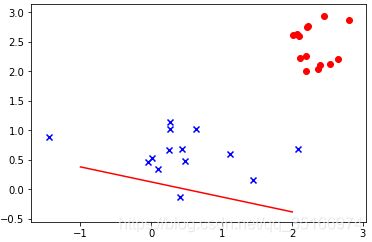Python实现感知机算法(原始形式、对偶形式)
上一篇文章给出了感知机算法的原理,这里给出Python实现感知机算法的代码:
感知机原始形式实现代码:
# -*- coding: utf-8 -*-
"""
Created on Sun Jul 14 09:48:09 2019
@author: 等等登登-Ande
E-mail:[email protected]
感知机算法原始形式实现(perception)
data为输入数据
label为标签
n为学习率
inter为迭代次数
"""
import numpy as np
import matplotlib.pyplot as plt
def perception(data,label,n,inter):
raw,col = np.shape(data)
w = np.random.randn(1,col)
b = np.random.randn(1)
x1 = -1
y1 = (-1/w[:,1])*(np.dot(w[:,0],x1)+b)
x2 = 2
y2 = (-1/w[:,1])*(np.dot(w[:,0],x2)+b)
plt.plot([x1,x2],[y1,y2],color='red')
plt.scatter(data[1:15,0],data[1:15,1],color='blue',marker='x')
plt.scatter(data[16:,0],data[16:,1],color='red',marker='o')
plt.show()
for times in range(inter):
for i in range(raw):
if -label[i-1]*(np.dot(w,(data[:][i-1]))+b) < 0:
w -= n*label[i-1]*data[:][i-1]
b -= n*label[i-1]
elif -label[i-1]*(np.dot(w,(data[:][i-1]))+b) == 0:
break
return w,b
if __name__ == '__main__':
data = np.array([
[-0.6508, 0.1097],
[-1.4492, 0.8896],
[2.0850, 0.6876],
[0.2626, 1.1476],
[0.6418, 1.0234],
[0.2569, 0.6730],
[1.1155, 0.6043],
[0.0914, 0.3399],
[0.0121, 0.5256],
[-0.0429, 0.4660],
[0.4340, 0.6870],
[0.2735, 1.0287],
[0.4839, 0.4851],
[0.4089, -0.1267],
[1.4391, 0.1614],
[2.9115, 2.1973],
[2.3654, 2.0475],
[2.2144, 2.7515],
[2.2013, 2.0014],
[2.6483, 2.2183],
[2.1147, 2.2242],
[2.7970, 2.8795],
[2.0625, 2.6366],
[2.5307, 2.1285],
[2.2200, 2.7777],
[2.3957, 2.1076],
[2.1013, 2.5989],
[2.4482, 2.9455],
[2.0149, 2.6192],
[2.2012, 2.2611]
])
label = np.array([-1, -1, -1, -1, -1, -1, -1, -1, -1, -1, -1, -1, -1, -1, -1, 1, 1, 1, 1, 1, 1, 1, 1, 1, 1, 1, 1, 1, 1, 1])
w,b = perception(data,label,0.5,1000)
x1 = -2
y1 = (-1/w[:,1])*(np.dot(w[:,0],x1)+b)
x2 = 3
y2 = (-1/w[:,1])*(np.dot(w[:,0],x2)+b)
plt.plot([x1,x2],[y1,y2],color='red')
plt.scatter(data[1:15,0],data[1:15,1],color='blue',marker='x')
plt.scatter(data[16:,0],data[16:,1],color='red',marker='o')
plt.show()运行效果:
感知机对偶形式实现代码:
# -*- coding: utf-8 -*-
"""
Created on Wed Jul 17 10:53:30 2019
@author: 等等登登-Ande
E-mail:[email protected]
感知机算法对偶形式实现(perception)
data为输入数据
label为标签
n为学习率
inter为迭代次数
"""
import numpy as np
import matplotlib.pyplot as plt
def perception_an(data,label,n,inter):
#初始化参数
a = np.random.randn(len(data))
b = 0
Gram = np.dot(data,data.T)
for k in range(inter):
for i in range(len(data)):
tmp = 0
for j in range(len(data)):
tmp += a[j]*label[j]*Gram[i][j]
tmp += b
if (label[i]*tmp <= 0):
a[i] += n
b += n*label[i]
w = 0
for i in range(len(a)):
w += a[i]*label[i]*data[i,:]
return w,b
if __name__ == '__main__':
data = np.array([
[-0.6508, 0.1097],
[-1.4492, 0.8896],
[2.0850, 0.6876],
[0.2626, 1.1476],
[0.6418, 1.0234],
[0.2569, 0.6730],
[1.1155, 0.6043],
[0.0914, 0.3399],
[0.0121, 0.5256],
[-0.0429, 0.4660],
[0.4340, 0.6870],
[0.2735, 1.0287],
[0.4839, 0.4851],
[0.4089, -0.1267],
[1.4391, 0.1614],
[2.9115, 2.1973],
[2.3654, 2.0475],
[2.2144, 2.7515],
[2.2013, 2.0014],
[2.6483, 2.2183],
[2.1147, 2.2242],
[2.7970, 2.8795],
[2.0625, 2.6366],
[2.5307, 2.1285],
[2.2200, 2.7777],
[2.3957, 2.1076],
[2.1013, 2.5989],
[2.4482, 2.9455],
[2.0149, 2.6192],
[2.2012, 2.2611]
])
label = np.array([-1, -1, -1, -1, -1, -1, -1, -1, -1, -1, -1, -1, -1, -1, -1, 1, 1, 1, 1, 1, 1, 1, 1, 1, 1, 1, 1, 1, 1, 1])
w,b = perception_an(data,label,0.5,1)
x1 = -2
y1 = (-1/w[1])*(np.dot(w[0],x1)+b)
x2 = 3
y2 = (-1/w[1])*(np.dot(w[0],x2)+b)
plt.plot([x1,x2],[y1,y2],color='red')
plt.scatter(data[1:15,0],data[1:15,1],color='blue',marker='x')
plt.scatter(data[16:,0],data[16:,1],color='red',marker='o')
plt.show()运行效果:
上面就是python实现感知机的代码,希望对大家有所帮助~


